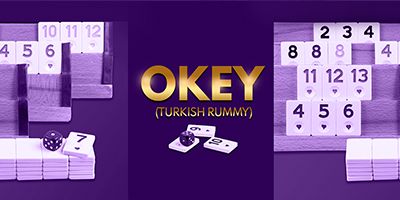Okey Game (Turkish Rummy)
In Turkey, Okey is a popular Rummy-like card game that is played using a set of 106 wooden tiles. On the faces of the tiles, the numerals 1 through 13 are printed in various colours. Turkish Rummy, a popular tile-based game, gets its name from the term "joker."
It's a fun and fascinating activity that's comparable to classic card games like Rummy or Canasta, except that, unlike Rummikub, it's played with tiles rather than cards.
Each number has eight tiles: two red, two yellow, two green, and two black. There are also two unusual tiles with no numbers, which are referred to as "fake jokers" in this game (in Turkish "sahte okey"). Because the backs of the tiles are plain, they all look the same when they're face down on the table or in the hands of another player.
Take a look at the tile set in the image below. These are the tiles you'll be using in your game.
How to Play Okey?
Okey is a rummy variant that is played with tiles rather than cards. You'll need to distribute tiles to all of the players and then arrange the extra tiles once you've set up the game and chosen the okey (or wild card). Players do not reveal their hands unless they have a complete winning hand. The scoring is determined by how a player wins, but instead of collecting points for a winning hand, losers lose points.
Set Up:
- Get a Rack.
- Shuffle the tiles.
- Throw the dice to choose a dealer.
- Make 5 stacks of 21 Tiles with one tile left over.
- Extra tile goes to the dealer.
- Each player should line up their stacks in front of them in a horizontal line.
Choose Okey:
- To select which stack to begin with, have the dealer roll the dice.
- To select the tile, roll the die once more.
- Show off your okey. The dealer's choice of tile aids in the selection of the joker (or okey) for this round. Place that tile face-up on top of the stack. The okey tile is the same colour as the pulled tile and one number higher.
Distribute the Tiles:
- Begin with the player to the dealer's right. That player places the stack with okey on top to the right of the stack. Then the player to the right of the first player takes the stack to the right of the first player's stack. You'll need to re-distribute the leftover tiles once each player has two full stacks.
- After everyone has two complete stacks of tiles, distribute the remaining tiles.
- Except for the first player, who will have 16, each player should end up with 15 tiles.
- Place the remaining tiles in the table's centre.
Play the Game:
- Examine your tiles and then discard one. Place your discarded tiles to the right of the tiles you're currently playing with, facing up.
- For each new turn, choose a new tile. Each player can draw a new tile from the stacks in front of them as they take their next turn, progressing from left to right and from the top of the stack down. They can also take a tile from another player's discard pile.
- Remove the extra tile and throw it away. You'll need to discard another tile once you've chosen your new tile. Place the tile face-up to the right of your other tiles when you discard them.
- Form runs and sets. You must disclose a winning hand: a collection of sets and runs, in order to win the round. A set consists of three or four tiles that are all the same number but in different colours. Three or more consecutively numbered tiles of the same colour form a run.
- To win the round, reveal a winning hand. You can disclose your hand to win the game once you have all 14 of your tiles organised in runs or sets. If you don't have a full winning hand, don't expose your runs or sets.
Okey Game Sets and Runs
A winning hand is made up of 14 tiles that are fully made up of sets and runs, such as two sets of three and two runs of four, or a run of six plus a run of four plus a set of four. At any given time, no tile can be used in more than one combination (set or run).
- Winning Hand
Seven pairs can be used to make a winning hand. Two identical tiles, such as two black 9s, must make up each pair. Two tiles with the same number but different colours do not create a pair; the colours must match.
- Seven Pairs Winning Hand
If you have a winning hand, you can finish the game by revealing all 14 of your tiles and discarding your last tile on the table's centre pile. Except for the discards and the face-up tile in the centre, no tiles are revealed until a player presents a winning hand: no sets or runs are revealed throughout the game.
- Jokers
The (actual) jokers are determined at the start of each new round. The jokers are the two tiles that have the same colour as the face up tile but one more in number. These tiles can be used to symbolise any tile the holder wants to finish a set or run. If the red 4 is face up, for example, the red 5s are jokers. A run would be blue 6 – red 5 – red 5 – blue 9, with jokers for the blue 7 and 8. Alternatively, a set would be yellow 10 – black 10 – red 5, with the red 5 representing the blue or red 10. A joker can be used with any tile when collecting a hand of seven pairs.
- Real Jokers
The two counterfeit jokers (tiles with a shamrock on them) are only used to represent the joker tiles. As a result, the bogus jokers are played as red 5s when red 5s are jokers. A red 4 – fake joker – red 6 counts as a run in this example, while a black 5 – blue 5 – yellow 5 – false joker counts as a set.
- False Jokers
You do not have to expose a winning hand of sets and runs that includes at least one joker right away. You can keep playing if you like in the hopes of producing a winning hand with a joker as the final discard tile.
Your win is worth twice as much as an ordinary win if you can end the game by discarding a joker and exposing your remaining 14 tiles as a winning hand.


